Meeting India’s growing demand for saffron
• Iran is the largest producer as well as exporter of saffron in the world, while in India, J&K is the largest saffron producing state.
• India’s share in global exports is only 0.5% at US$ 1 million in 2019. Its share in global import is 9.4% at US$ 18.8 million in 2019.
• A key challenge is poor productivity of saffron cultivation in India vis-a-vis major producers such as Iran and Italy.
• Proper weeding technology and expansion in area under saffron cultivation need to be promoted to cater to the growing domestic demand.
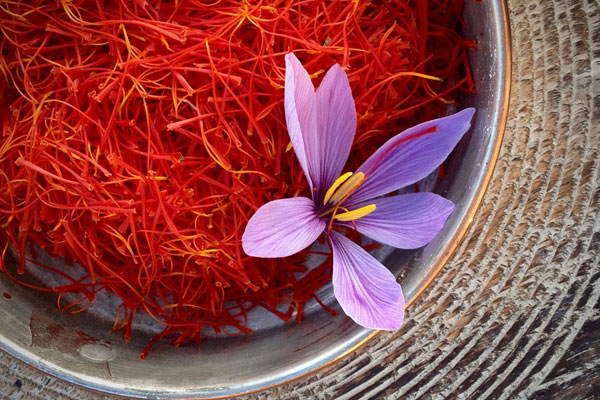
Saffron is the most expensive spice in the world. It is currently being cultivated in various countries of the world such as Iran, India, Greece, Spain, Italy, Turkey, France, Azerbaijan, Egypt, United Arab Emirates, Afghanistan, Iraq and Pakistan. Iran is the largest producer as well as exporter of saffron in the world. In India, J&K is the largest saffron producing state. The unique aspect of saffron production and trade in India is that it is one of the topmost exporters as well as importers of saffron; indicating that domestic demand exceeds the domestic production.
Global Scenario
Iran contributes about approximately 88% of the world’s saffron production by occupying a maximum area of 43.408 thousand hectares* under saffron cultivation with the production of 174 tonnes* and the productivity of 4 kg/ha*. Other key producers are India, Afghanistan, Greece, Azerbaijan, Spain, Morocco and Italy. Despite small area and volume, Italy has very high productivity.
The reasons for higher saffron production in Iran are as follows:
• Largest area- 43.408 thousand hectares
• Shorter age of saffron fields
• Higher planting density
• Proper nutrient management with adequate irrigation facilities
• Non-incidence of corm rot and proper weed management practices
Source: Annual Report of Directorate of Agricultural Jammu and Kashmir, 2014
Production of Saffron in the erstwhile state of J&K
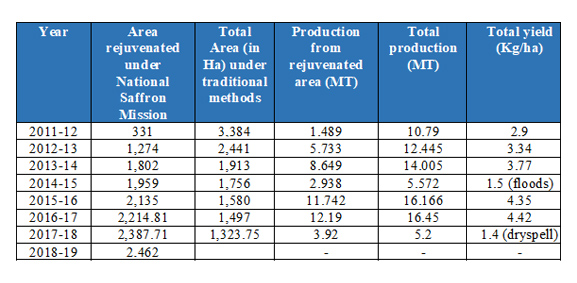
Source: http://diragrikmr.nic.in/assets/files/Saffron_Presen.pdf
A key challenge is poor productivity of saffron cultivation in India vis-a-vis major producers such as Iran and Italy. Steps such as National Saffron Mission have led to increased productivity in the rejuvenated area. However the most volatility in productivity is caused due to natural calamities such as floods and dry spells. Another concern is that the area under production of saffron has declined as compared to 1996 with some improvement in mid 2000s.
Trade Overview
Iran is the biggest exporter with a share of 42.4% in total exports while Hong Kong, China is the biggest importer with a share of 17.1% in total imports of saffron in the world in 2019. India’s share in global exports is only 0.5% at US$ 1 million in 2019. Its share in global import is 9.4% at US$ 18.8 million in 2019. A key insight from the global exports of saffron is the stupendous rise of Afghanistan as saffron exporter. From zero exports till 2009, it has increased exports to its current state of US$ 28.7 million in 2019.
Top exporters of saffron
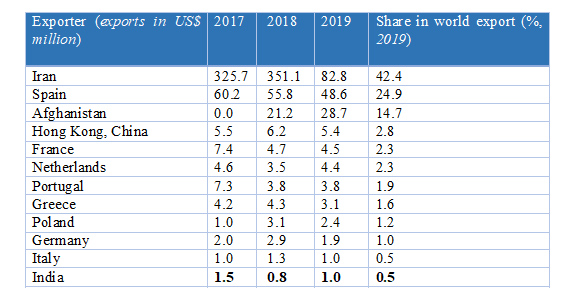
Source: Trademap.org
Top importers of saffron
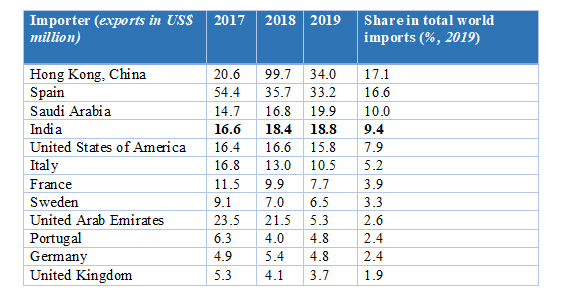
Source: Trademap.org
India’s Trade Overview
The top 3 importers of saffron from India are Oman, Qatar and US in 2018-19. India exported US$ 0.95 million worth of saffron in 2018-19 while it exported US$ 0.77 million worth of saffron in 2019-2020 (Apr-Jan).
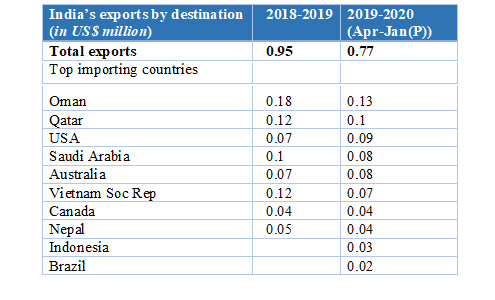
Source: Ministry of Commerce and Industry
The top 3 exporters of saffron to India are Afghanistan, Hong Kong and UAE in 2018-19. India imported US$ 19.5 million worth of saffron in 2018-19 while it imported US$ 15.38 million worth of saffron in 2019-2020 Apr-Jan.
India’s imports of saffron by country
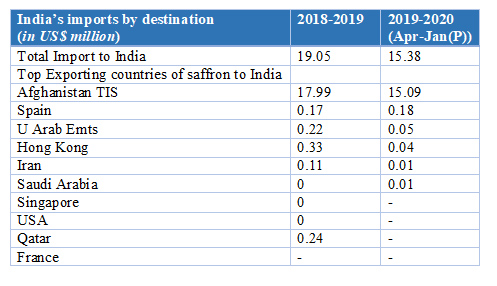
Source: Ministry of Commerce and Industry
Trends in India’s saffron trade
As evident the export is declining while the import of saffron is increasing over the years. Especially after 2015, the import of saffron is consistently increasing with a concomitant with a decline in export.
The rise in imports after 2006 can be attributed to the shift of domestic consumption pattern owing to better incomes and hence greater demand. It increased primarily to meet the demand-supply mismatch. However the recent shift towards imports i.e. after 2015 is accompanied with a concomitant decline in exports and hence it is a cause of concern.
Another key factor is low productivity of saffron cultivation in India. National Saffron Mission has been able to address it to some extent. However, other challenges persist such as unstable production due to dry spell and floods in the major saffron producing state.
Source: Trademap.org, in US$ million
Conclusion
India’s share in global exports is only 0.5% at US$ 1 million worth of export in 2019. India’s share in global import is 9.4% at US$ 18.8 million worth of import in 2019. Iran is the biggest exporter with a share of 42.4% in total exports while HongKong, China is the biggest importer with a share of 17.1% in total imports of saffron in the world in 2019.
India is one of the topmost exporters as well as importers of saffron; indicating that domestic demand exceeds domestic production. India primarily imported saffron from Afghanistan, Hong Kong and UAE in 2018-19.
A key challenge is low productivity of saffron cultivation in India vis-a-vis major producers such as Iran and Italy. Another challenge is the rise of new competitors such as Afghanistan.
The real cause of concern is dwindling production of saffron in India, no gradual increase in the area under cultivation of saffron, rising import and declining exports of the product since 2015. However, the biggest reason for volatility in productivity is natural calamities such as floods and dry spell.
Major challenges in terms of domestic saffron production are low productivity, high incidence of corm rot disease, age of saffron fields and low density. Hence proper weeding technology and expansion in area under saffron cultivation need to be promoted.








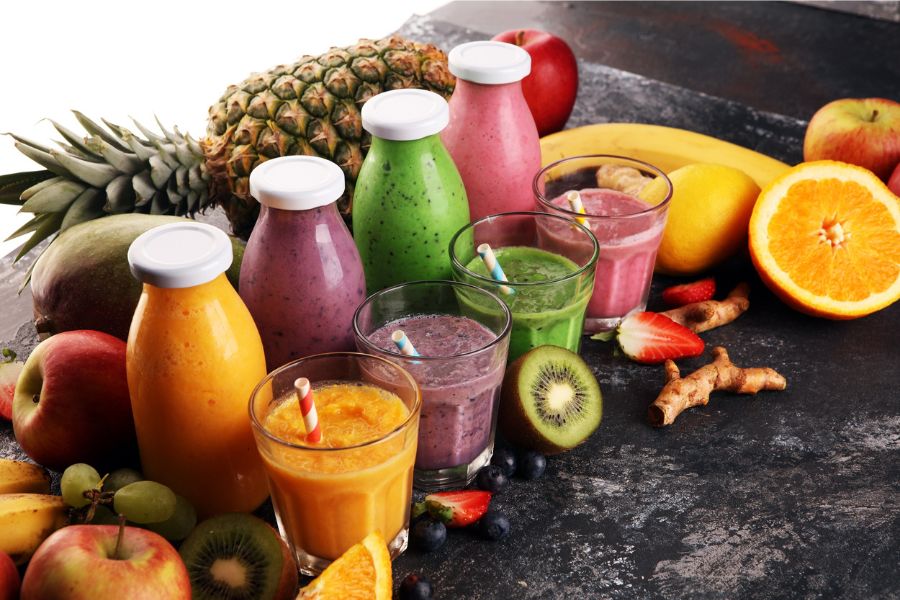
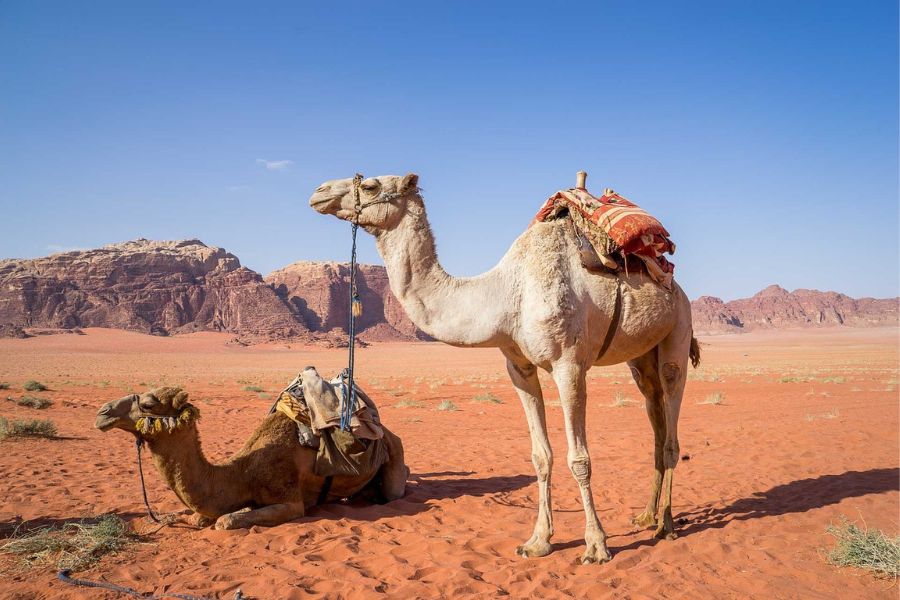



Leave a comment